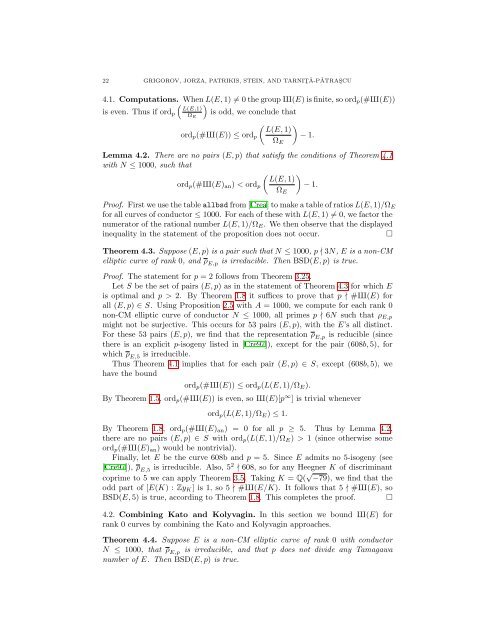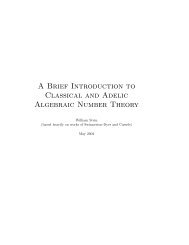COMPUTATIONAL VERIFICATION OF THE BIRCH ... - William Stein
COMPUTATIONAL VERIFICATION OF THE BIRCH ... - William Stein
COMPUTATIONAL VERIFICATION OF THE BIRCH ... - William Stein
You also want an ePaper? Increase the reach of your titles
YUMPU automatically turns print PDFs into web optimized ePapers that Google loves.
22 GRIGOROV, JORZA, PATRIKIS, STEIN, AND TARNIT¸ Ǎ-PǍTRAS¸CU<br />
4.1. Computations.<br />
<br />
When<br />
<br />
L(E, 1) = 0 the group X(E) is finite, so ordp(#X(E))<br />
L(E,1)<br />
is even. Thus if ordp is odd, we conclude that<br />
ΩE<br />
<br />
L(E, 1)<br />
ordp(#X(E)) ≤ ordp<br />
− 1.<br />
Lemma 4.2. There are no pairs (E, p) that satisfy the conditions of Theorem 4.1<br />
with N ≤ 1000, such that<br />
<br />
L(E, 1)<br />
ordp(#X(E)an) < ordp<br />
− 1.<br />
Proof. First we use the table allbsd from [Crea] to make a table of ratios L(E, 1)/ΩE<br />
for all curves of conductor ≤ 1000. For each of these with L(E, 1) = 0, we factor the<br />
numerator of the rational number L(E, 1)/ΩE. We then observe that the displayed<br />
inequality in the statement of the proposition does not occur. <br />
Theorem 4.3. Suppose (E, p) is a pair such that N ≤ 1000, p ∤ 3N, E is a non-CM<br />
elliptic curve of rank 0, and ρ E,p is irreducible. Then BSD(E, p) is true.<br />
Proof. The statement for p = 2 follows from Theorem 3.25.<br />
Let S be the set of pairs (E, p) as in the statement of Theorem 4.3 for which E<br />
is optimal and p > 2. By Theorem 1.8 it suffices to prove that p ∤ #X(E) for<br />
all (E, p) ∈ S. Using Proposition 2.5 with A = 1000, we compute for each rank 0<br />
non-CM elliptic curve of conductor N ≤ 1000, all primes p ∤ 6N such that ρE,p<br />
might not be surjective. This occurs for 53 pairs (E, p), with the E’s all distinct.<br />
For these 53 pairs (E, p), we find that the representation ρ E,p is reducible (since<br />
there is an explicit p-isogeny listed in [Cre97]), except for the pair (608b, 5), for<br />
which ρ E,5 is irreducible.<br />
Thus Theorem 4.1 implies that for each pair (E, p) ∈ S, except (608b, 5), we<br />
have the bound<br />
ordp(#X(E)) ≤ ordp(L(E, 1)/ΩE).<br />
By Theorem 1.5, ordp(#X(E)) is even, so X(E)[p ∞ ] is trivial whenever<br />
ΩE<br />
ΩE<br />
ordp(L(E, 1)/ΩE) ≤ 1.<br />
By Theorem 1.8, ordp(#X(E)an) = 0 for all p ≥ 5. Thus by Lemma 4.2,<br />
there are no pairs (E, p) ∈ S with ordp(L(E, 1)/ΩE) > 1 (since otherwise some<br />
ordp(#X(E)an) would be nontrivial).<br />
Finally, let E be the curve 608b and p = 5. Since E admits no 5-isogeny (see<br />
[Cre97]), ρ E,5 is irreducible. Also, 5 2 ∤ 608, so for any Heegner K of discriminant<br />
coprime to 5 we can apply Theorem 3.5. Taking K = Q( √ −79), we find that the<br />
odd part of [E(K) : ZyK] is 1, so 5 ∤ #X(E/K). It follows that 5 ∤ #X(E), so<br />
BSD(E, 5) is true, according to Theorem 1.8. This completes the proof. <br />
4.2. Combining Kato and Kolyvagin. In this section we bound X(E) for<br />
rank 0 curves by combining the Kato and Kolyvagin approaches.<br />
Theorem 4.4. Suppose E is a non-CM elliptic curve of rank 0 with conductor<br />
N ≤ 1000, that ρ E,p is irreducible, and that p does not divide any Tamagawa<br />
number of E. Then BSD(E, p) is true.
















